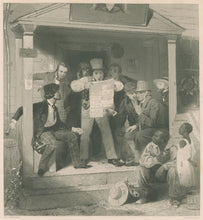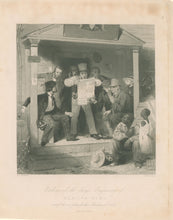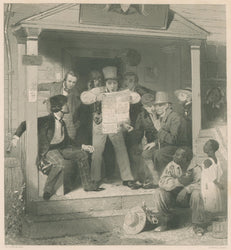Richard Caton Woodville. “Etching of the large Engraving of MEXICAN NEWS one of The six plates for the Number of 1851.”
Credits to “R.C. Woodville” and the etcher being “Alfred Jones.” 6 7/8 x 6 1/8 (image) on sheet 10 x 7 3/4. Frontispiece for Bulletin of the American Art-Union. Reproduced in Maybelle Mann’s The American Art Union (Jupiter, FL, 1987): pp. 91. This small print is probably as scarce as the larger version which it advertised.
The AAU is well known today for the thirty-six engravings it published based on the paintings of some of the most luminous names in American art, e.g. George Caleb Bingham, Thomas Cole, F.O.C. Darley, R.C. Woodville, Asher B. Durand, and William Sidney Mount. The association is especially important for the seminal role it played in stimulating American art and for spreading an awareness of this art throughout the country. With its gallery and thousands of subscribers, the AAU probably had more to do than any other force with the success of many of America’s nineteenth century artists and the popularization of their work. The legacy of the American Art Union is immense and its prints are an important part of that.
“Mexican News” is a defining piece of American genre art that fits with American history of the 1840s and 50s. By 1834 Stephen Austin’s Texas colony numbered 20,000 white Americans and 2,000 slaves outnumbering Spanish speaking inhabitants by four to one, so when President Santa Anna declared a unified constitution in 1835, Texas pulled away from Mexico. By 1837 Texas was declared a republic and recognized by the United States. By 1845 the United States had annexed Texas and acquired California and Oregon. The great West was open to Americans, but Mexico took moves to go to war with the United States. The war was very popular while neither legal nor moral, so the people of the United States were entranced by news of the battles. This picture shows genre elements of old and young, rich and poor, men and woman, slaves and free men, all entranced by the latest newspaper. All the states bordering the Mississippi River sent volunteers to the war, and this rural scene reflects that passionate interest in 1846. Accommodation of the huge new territories would draw the focus of Americans for the next decade. Many other details of American life are in the picture: clothing, signs, utensils, and architecture.





